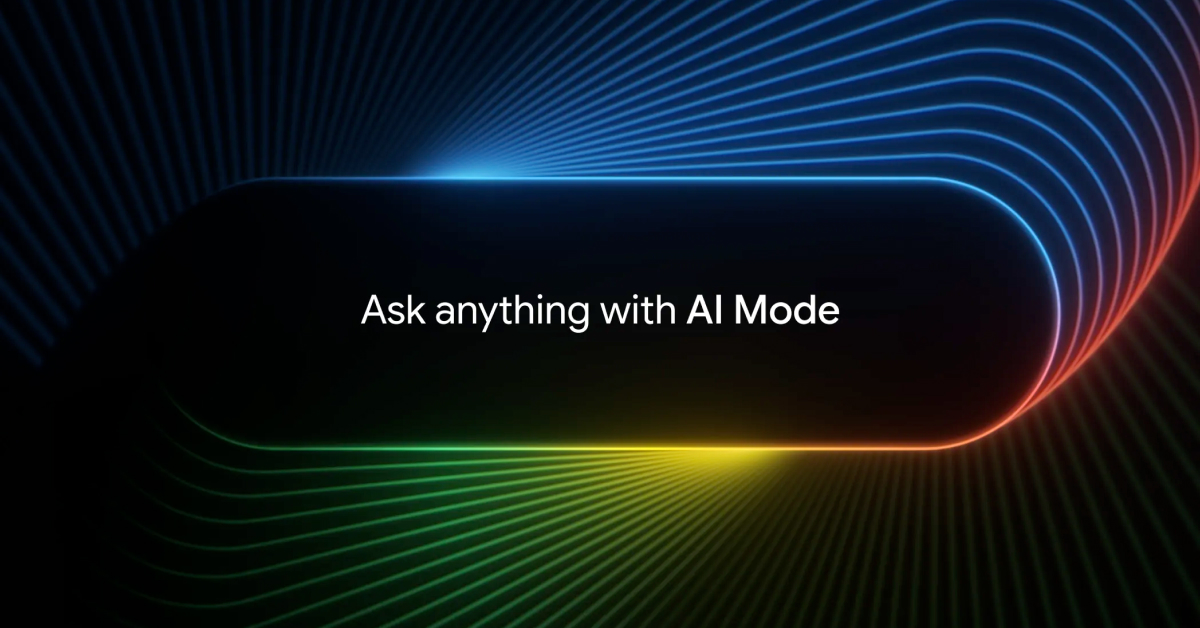
How should content marketers adapt their strategy for AI search engines?
Content marketing has fundamentally shifted from optimizing for clicks to earning citations in AI-generated responses. Traditional search is disappearing as users abandon blue links for instant answers from AI platforms like Google AI Overview, ChatGPT, Claude, and Perplexity, which now process millions of queries daily and evaluate brands based on comprehensive expertise rather than keyword optimization.
Five key forces are making this transformation difficult for content teams: outdated pre-AI content strategies with obsolete KPIs, leaner marketing teams shouldering larger workloads, explosive growth in content demand across multiple channels, faster information cycles that make editorial calendars feel outdated, and skyrocketing paid media costs that increase pressure on owned content performance. Success now requires automating the collection and analysis of content signals to understand audience needs and positioning your brand as the most authoritative, relevant answer for AI platforms to feature, as data-driven marketing strategy has evolved from a nice-to-have to an essential competitive requirement.
Contents
- How AI Changed Search Overnight
- The Five Forces Making AI Answer Engine Transformation Difficult for Content Teams
- What Success Looks Like: How Brands Appear in AI Platforms
- The Brand Authority Advantage
---
Traditional search remained basically the same for 20 years. We went down rabbit holes of Google search results pages, opening windows full of tabs that we lost. Then we opened more tabs. And more tabs. Lost in the maze of the “attention economy”, where answers are secondary to clicks.
Looking at it through a game theory lens: the incentive structure was flawed. Users wanted answers, but publishers got paid for clicks.
And then the two-decade old search experience changed overnight. Users got instant answers, trusted referrals, and links to content through AI platforms like Google AI Overview and AI Mode, ChatGPT, Claude, Copilot, Grok, and Perplexity.
Traffic plunged. SearchEngineJournal featured a study showing traffic went down 32% for the number 1 ranked result when it appeared beneath Google's AI Overview. The Guardian reported that news sites lost 79% of traffic when answers were delivered through AI Overview.
Users, on the other hand, were psyched to stop searching and start answering. Google's blog, The Keyword, reported:
"AI Overviews is one of the most successful launches in Search in the past decade. As people use AI Overviews, we see they’re happier with their results, and they search more often. In our biggest markets like the U.S. and India, AI Overviews is driving over 10% increase in usage of Google for the types of queries that show AI Overviews."
We're also seeing reports of overall traffic going down but conversions going up. The Wall Street Journal recently profiled Clerk.com, which reported a 9% increase in sign-ups for its platform coming from AI searches.
The scale of this shift is already big and getting bigger. Perplexity went from handling 250 million search queries in July 2024 to 780 million search queries in May 2025. ChatGPT famously reached 1 million users five days after it launched, and now has 180 million monthly active users.
What does this mean for brands? AI platforms are getting smarter about recognizing true expertise. Instead of ranking individual pages based on keywords, they're evaluating your brand's comprehensive knowledge across all your content: blogs, videos, product pages, podcasts, and more. They want to understand: are you actually an authority on this topic, or just optimizing for search terms? Understanding how AI search evaluates topical authority is the first step to earning citations.
Now that we have a view of the new game board and rules, content marketers are revising their strategy: from keywords to answers, from broad coverage to deep expertise, from evergreen content to topical relevance.
We are all struggling to adapt to this new reality. Here's why:
Pre-AI Content Strategy: Remember when mobile-first content creation was the big transition? When those gorgeous, wide webpages broke down on mobile? But only our audience saw it. We missed it. Sitting at our desks with giant monitors optimized for content creation, design, and web development, everything looked great. But our audience was on the move, on their phone. It's that all over again. Audience behavior has shifted in a blink, but we're still using outdated KPIs to measure success. And the new KPIs will take some getting used to. Search Engine Land recently published "12 new KPIs for the generative AI search era". It includes: chunk retrieval frequency, embedding relevance score, and attribution rate in AI outputs. Where's that tool tip thing when I need it?
Leaner Content Marketing Teams: Marketing teams have gotten hit hard over the past two years. Intel just outsourced their entire marketing organization to an AI-enabled Accenture team. More and more, we talk to content marketing teams of one or two people shouldering the workload of a team that used to be much larger. This means lots of publishing pressure and little room for error or experimentation. As I wrote this, WSJ published the article, "CEOs Trumpet Smaller Workforces as a Sign of Corporate Health."
Explosion in Content Demand: While the teams have gotten smaller, their remit has gotten bigger. Content teams are being asked to publish more frequently, with higher impact, across more channels: blogs, newsletters, podcasts, LinkedIn, and more. One of our content marketing colleagues put it best: "Email marketing used to be my whole job. Now it's just the third comma in my title." Fast Company reported stats to back up that feeling:
Adobe surveyed more than 1,600 marketers, and nearly all respondents (96%) have seen content demand increase at least 2X during the last two years, with 62% saying it has increased 5x or more. The research also shows that marketers are shifting their content production process and strategies to keep pace, as most marketers (71%) also anticipate content demand to grow more than 5x between now and 2027.
Faster Information Cycles: Topics and trends and become saturated and outdated within days rather than months. As an avid listener to the Prof G Markets podcast (which I take heat for) I was surprised when their weekly podcast all of sudden started feeling outdated. YouTube comments chimed in immediately with "constructive feedback." Not long after, they announced the upcoming launch of a daily podcast. Go Ed Elson!
In the words of The Content Marketing Institute's Robert Rose: “A timeless piece of content doesn’t automatically mean the content will stand the test of time. And content that stands the test of time isn’t necessarily timeless.”
Skyrocketing Costs for Paid Media: Rising ad costs are making owned audiences more valuable than ever, putting additional pressure on content marketing to build direct relationships with prospects and customers. Additionally, social platforms have made it harder to get visibility with your own audience unless you sponsor the post. The ROI on content marketing has gone up with the cost of paid ads. The value of reaching your audience through your channels at your desired frequency has never been higher.
Constant Contact cited Statista research showing: "The average ROI for email marketing is $36 for every dollar spent. Some industries do even better, with a $45 ROI for every dollar spent by retail, ecommerce, and consumer goods businesses."
These forces create a perfect storm where traditional content approaches simply cannot scale. Teams trying to maintain their old methods find themselves constantly behind, creating content that gets lost in the noise while burning through resources on low-impact publishing.
The solution isn't working harder or publishing more. It's automating the collection and analysis of content signals to understand what your audience actually wants and how to make your brand the most authoritative, relevant answer for AI platforms to feature.
As HubSpot said in it's State of Marketing 2025 report: Data-driven marketing strategy is no longer a nice-to-have.
Given the new challenges facing content marketers, what does success actually look like? Despite smaller teams and higher demands, some brands are thriving in AI search results. They're cited as authoritative sources, quoted as answers to questions, and recommended as solution providers.
As Michael King, Founder and CEO of iPullRank, wrote: "This is the new 'rank.' Citation in the AI Overview is how users now encounter your content. Being referenced as the source of truth, especially high in the answer delivers visibility and supports brand awareness even without a click."
Here's how AI citations look on five AI answer engines using the example prompt: "best B2B software managing expenses."
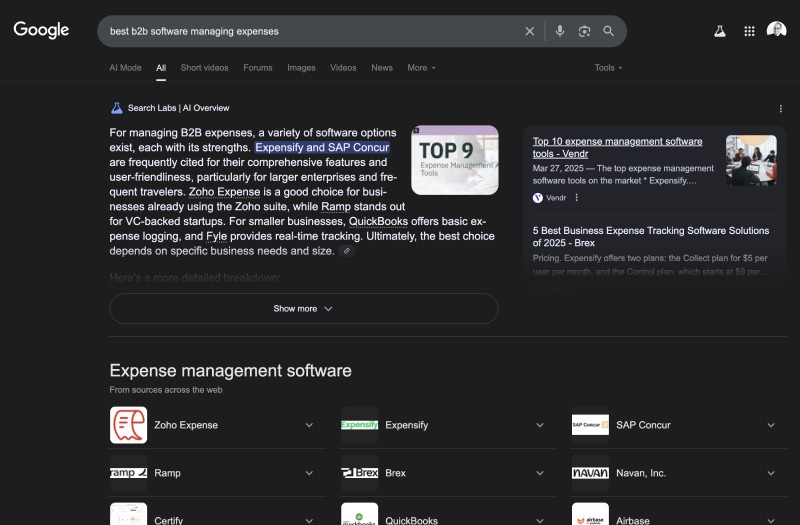
Google's AI Overview takes the top of the page, with citations to brand content on the right. Next in line: the entity carousel, followed by the classic 10 blue links (below the fold - not shown). Even the top ranked result requires a user to scroll.
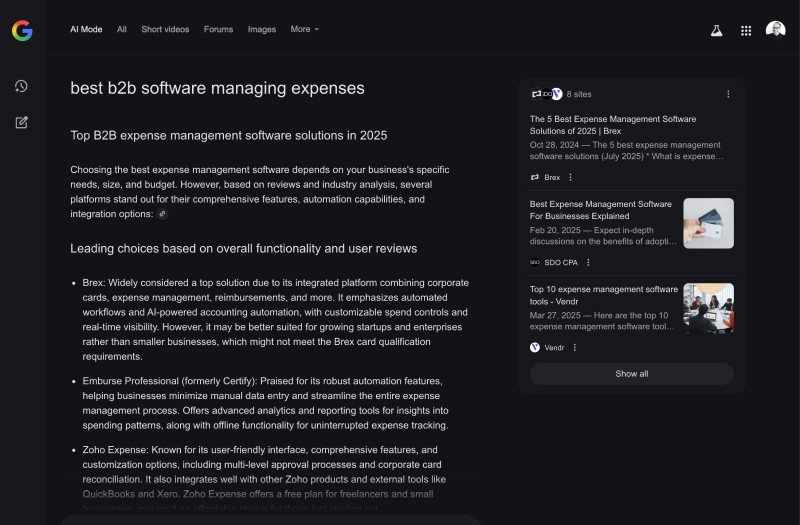
When users hit the "AI Mode" toggle at the top, classic Google search switches to a ChatGPT-like conversational interface. The classic list of blue links is gone. Instead, you get a living document of AI-generated copy with clickable citations. For brands, this means visibility isn’t just about ranking for one query. It’s about being authoritative enough to feed the narrative Google's Gemini is writing in real time.
Michael King said it best, again: "It is no longer about appearing for a keyword; it is about being encoded into the model’s understanding of the information domain."
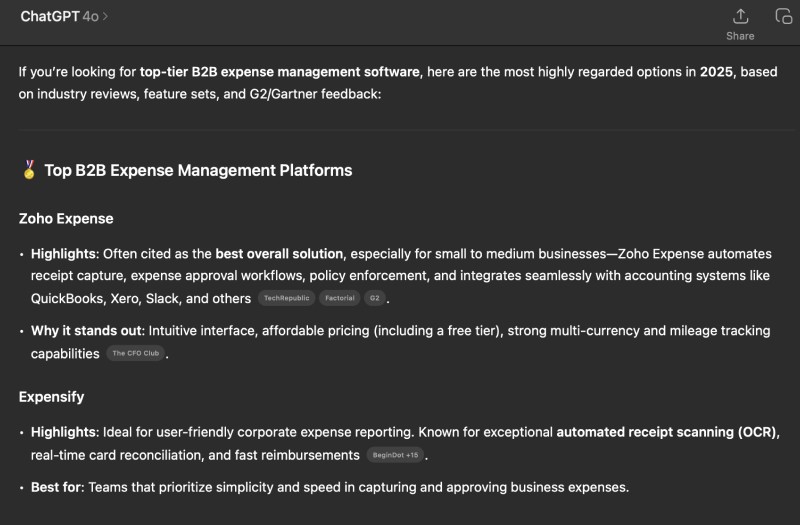
It can be harder to get ChatGPT to volunteer citations. On my first prompt, it gave answers with no sources. Only after asking it to “go back and cite its sources” did these pill‑style citation buttons appear. Verifying these citations is critical. Because it collapses the links into pill-style buttons, you need to click through to ensure the content is what you're expecting.
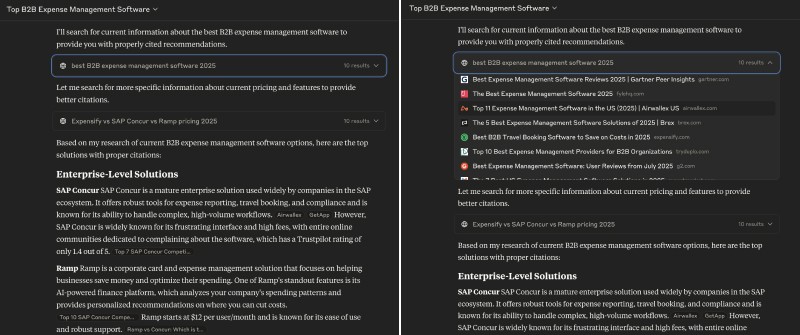
In this side-by-side view, you can see the initial results on the left, with citations collapsed in a dropdown menu. On the right, you can see the expanded citations, which give enough context to make some initial research decisions.

Another side-by-side view. On the left, Perplexity's AI‑written summary with a table of software, features, and pricing. The "Sources" button in the center below the prompt. On the right, when that button is expanded, you get a list of citations with titles and publishers.
The new goal of content marketing is: get cited or get left out. Traditional SEO is disappearing from two directions: users are abandoning the tedious experience of navigating lists of blue links, and Google is moving away from keyword-based ranking to serve AI-generated answers.
When ChatGPT, Google AI Overview, or Perplexity answers a question, they're looking for content they can confidently cite and attribute. They want concise passages that back up their responses with credible information, not content optimized for traditional search algorithms.
AI engines aren't making decisions based (solely) on your keyword density or backlink profile. They're asking: "Is this brand an authoritative entity and is does this passage support the content being presented?"
Proactive brands aren’t just waiting to see if they’re cited. They’re feeding and training the system. They measure what their audience is searching for, what their industry is publishing, and what topics are trending across news, social, podcasts, and industry sites. Then they become the voice that answers those questions quickly and authoritatively.
In this new ecosystem, authority doesn’t come from optimizing yesterday’s keywords. It comes from leading tomorrow’s conversations. The brands that will lead won’t just track AI citations. They’ll shape the knowledge AI draws from by consistently publishing the most relevant, data-backed insights in their space.
Use our free tool to analyze your brand authority in Google Search Console data.
Traditional SEO focuses on ranking pages for keywords to drive clicks, while AI search optimization aims to get content cited as authoritative sources in AI-generated responses from platforms like ChatGPT, Google AI Overview, and Perplexity.
Five key forces are creating challenges: outdated content strategies with obsolete KPIs, leaner teams handling larger workloads, explosive growth in content demand across multiple channels, faster information cycles making editorial calendars outdated, and rising paid media costs increasing pressure on owned content performance.
AI platforms evaluate brands based on comprehensive expertise across all content types—blogs, videos, podcasts, product pages—rather than individual keyword-optimized pages. Success requires creating authoritative, well-sourced content that AI engines can confidently cite and attribute.
Success means being cited as authoritative sources, quoted as answers to questions, and recommended as solution providers across platforms like Google AI Overview, ChatGPT, Claude, and Perplexity, rather than just ranking for traditional search results.
Traditional metrics like organic traffic and keyword rankings remain important, but success now requires tracking new KPIs including chunk retrieval frequency, embedding relevance scores, attribution rates in AI outputs, and citation frequency across AI platforms rather than just measuring clicks and conversions.
© 2025 Forecast.ing, Inc. All Rights Reserved.